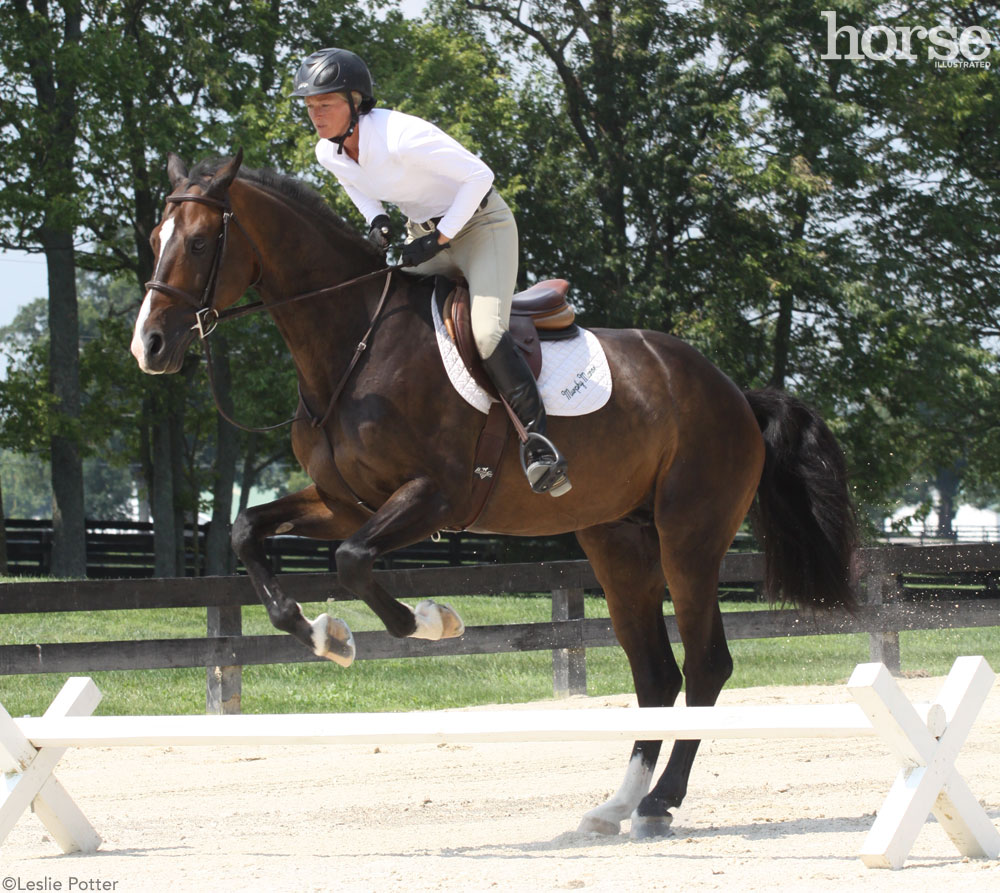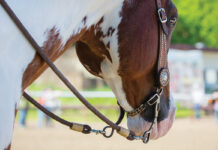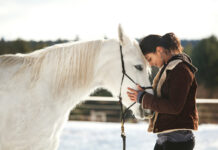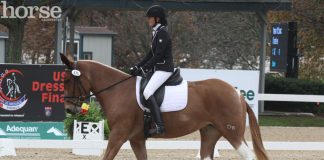Jenny knew she was pretty lucky to be able to school her young chestnut gelding during the winter months in a warm covered arena. “Good thing, too,” she muttered to Finnegan as she swung into her well-broken-in close-contact saddle. “We’ve got to work on our jumping form. I just know you have the talent to sweep our hunter division this year, but you’re just a little too green over fences. I wish I knew some way I could help you work more off your hind end and balance before the jumps, your eye — and mine — would seriously improve. We could kick butt.”

If you’ve never ridden cavalletti before, you would be interested to know that problems encountered during jumping or dressage can be overcome by incorporating them into your workouts. For dressage horses, cavalletti work is great for improving the walk, the trot and the balance; it benefits the action of a horse’s motion, and increases suspension and self-carriage. Hunters and jumpers also learn balance, but more importantly, cavalletti teaches these horses how to jump without stressing joints over actual fences. For all types of horses, cavalletti is beneficial for overall rideability, control and fitness. It’s just as helpful for the rider, too. The jumper rider learns to find that all-important distance from jump to jump, and the dressage rider gets a better understanding of balance and feel. But most of all, cavalletti is a lot of fun for riders of all disciplines since the patterns of the obstacles offer a pleasant change from the usual routine.
To help you learn more about cavalletti, Judy Martin, grand prix jumper trainer, and FEI-level dressage trainer Kathy Beal have offered their favorite exercises to help teach you the proper way to ride cavalletti. We’ve also provided you with some safety dos and don’ts, instructions on how to outfit your horse correctly, how to set up your cavalletti patterns, and exercises to help with specific problems or challenge areas.
Cavalletti Preparation
Safety Gear: Judy Martin is adamant about the use of safety helmets. “Don’t even look at a horse unless you have a helmet on,” she says. “Make it part of your riding apparel, just as you would your riding breeches and boots. There are too many dangerous aspects to riding to allow yourself to forgo your helmet. Your horse should wear protective boots, polo wraps or other legwear, both on front and back legs. A horse new to cavalletti may hit or scrape his legs until he becomes more educated, so protect him thoroughly.
Cavalletti Placement: Cavalletti can be dangerous if placed incorrectly, as uneven spacing can cause the horse to trip or step on the poles. Before beginning each workout, check the distance of your poles. Judy says, “If you have fixed cavalletti, keep in mind that these are quite stable and need to be placed carefully. The fixed X-style cavalletti can be turned to varying heights so be aware of how you’re setting these. The closer together they are, the lower they should be. However, the maximum height of the X-style is fine for canter cavalletti.” Distance between each cavalletti should be anywhere from 3 to 4 feet apart for trot work and 9 to 12 feet apart for canter work, depending upon the exercise and your horse’s stride length.
Execution: Cavalletti can be ridden at all three gaits and in jumping position, posting and sitting trot. “One of the best things to do is to start walking through your pattern first,” says Judy. This way your horse will have a chance to get his bearings over the poles. “Whatever position you choose to use to ride through the cavalletti just depends on what you’re trying to accomplish that day. You can choose the sitting trot if you want to use the poles for transition work. For instance, sit the trot and walk just before a single pole. Use the pole to help your horse think about the transition.” Aim to ride in the center of the poles and keep your eyes straight ahead,” she adds.
Take caution when introducing a horse to ground poles or cavalletti. If he’s only worked with ground poles, but has never trotted raised cavalletti, introduce one raised pole at a time, increasing the line as he becomes accustomed to the exercise. Have him go into the pattern straight, keep contact with his mouth light and leave him free to use his body correctly. Always urge him to go forward so that he learns to develop rhythm and tempo through the exercise.
Hunters & Jumpers
Judy Martin, who teaches and clinics in the Southern California area, has been a permanent fixture on the hunter/jumper circuit for years. Described by her students as a “trainer’s trainer,” Judy’s philosophy on horses and riding is well respected in the jumping community. She considers cavalletti a valuable tool to help further a horse and rider’s education. Here are some sample patterns and exercises.
Trot Rails. This exercise teaches a horse to raise his shoulders as he trots through the poles, and helps the horse keep his head and neck in a steady position. Trot poles will also help loosen and stretch him through his back and make him more elastic.
Set up this exercise by using the X-style cavalletti placed on the lowest turn, or use poles on the ground or set in low block holders. Use three to six poles set 3 feet apart. To add to this exercise, just add a small jump 9 to 12 feet away.
Simply approach the poles at a trot and continue through the pattern. If your horse hesitates, keep an active leg on him and steady contact to help his rhythm and activity.
Canter Poles. This canter pattern works to educate the horse on his leads, particularly the lead he doesn’t prefer. You can work the pattern by making your turns and bends on the difficult lead. For example, pick up the left lead, canter through the grid, over the pole on the far side, turn left and reenter the grid on the short side, exiting over the last pole. Use the X-style set on any length, or poles on the ground or in holders. The long side of the pattern is set four to five strides apart, and the short side is set three to four strides apart.
When performing this cloverleaf pattern, focus on his rhythm and balance, and don’t let him rush through the grid or leave strides out.
Gridwork With Jumps. Riding through this grid teaches a horse to jump quietly while learning to manage his balance and stride. You will start to add small jumps in this exercise. Set the distance between the pole and the crossrail to 9 feet. Set a small vertical jump 18 feet out. After your horse gets the hang of the three obstacles, place a small bounce (two jumps set 12 feet apart), four strides away. Your grid will also help you improve your own eye for distances as well as your jumping balance.
Oxers. This exercise is good for horses that rush their fences, because the horse must take his time to approach the second fence correctly. To get your horse to slow down, back off his fences and use his body more carefully while jumping, place two X-style cavalletti together, turned to the highest setting, to form a small oxer. Set an identical oxer two strides away. If your horse rushes this exercise, sit back immediately after clearing the first oxer and give a strong half-halt.
Dressage
Kathy Beal is an FEI-level dressage rider who has had great success training not only her own horses, but several client’s horses with cavalletti. “I work a horse in cavalletti each timeI ride them. I have my poles set up on one end of my arena and I incorporate them into my daily workout.” Here are some sample patterns and exercises for the dressage horse.
Longeing. This is a great way to introduce a green horse to cavalletti. Place X-style poles on the lowest setting, or use ground poles. Place three to seven poles in a fan shape. Longe your horse over at the trot, with you 4 feet away at the center.
20 Meter Figure 8. This exercise to help your horse increase his impulsion while staying rhythmic at the trot, improves suppleness, obedience and transitions. It also teaches the rider and the horse to think of transitions in advance. Place four poles or X-style cavalletti in a fan shape, about 4 feet apart. Trot through the poles in one direction, then change rein and circle 20 meters outside the poles and do trot/canter transitions.
Improving Impulsion and Thrust. Place five to seven poles or X-style cavalletti in a row 4 to 5 feet apart. Trot over the poles and pick up a canter immediately when you exit the row of poles. This helps prepare the horse and rider for transitions. Riders learn to keep the horse in front of the leg and responding to aids. Horses learn not to run into their canter transition.
Adjusting Stride Length. To help lengthen the horse’s stride, place five cavalletti 5 feet apart. Trot through, encouraging the horse to take a bigger stride by driving more with your leg. After exiting the pattern, circle 20 meters. Directly across from the cavalletti grid, make a 10-meter circle in collected sitting trot. Proceed on the 20-meter circle and lengthen stride in the trot through the cavalletti grid once more.
Canter Cavalletti. Cavalletti can also be used to help the horse use his back muscles. As the horse canters over the X-style cavalletti (can be raised to its maximum height), he pushes into the bit contact and stretches his neck. Pair two cavalletti to make an oxer. Place another cavalletti pair 18 feet out. Canter over the first oxer, then transition to the trot, then canter over the second oxer. This exercise encourages the horse to relax, slow down and listen to subtle seat aids.






Very informative and practical for schooling/training horses and riders.
This is a great article. I’m going to keep it for reference.
I loved this article. I have a QH mare that is trained in WP and doesn’t have much muscle tone in her back end. She sat most of the winter. I can’t wait to try some of these exercises into her routine. Thanks so much.
Wonderful article- I will use it at my lessons.
This is a great article. I will use more cavelitti in my lessons with my horses.
Excellent article, well written.
This is so helpful. I used to have trouble fitting in cavallettis into practices, but this gave great ideas.
Excellent article. Good exercises and suggstions to slow, etc.